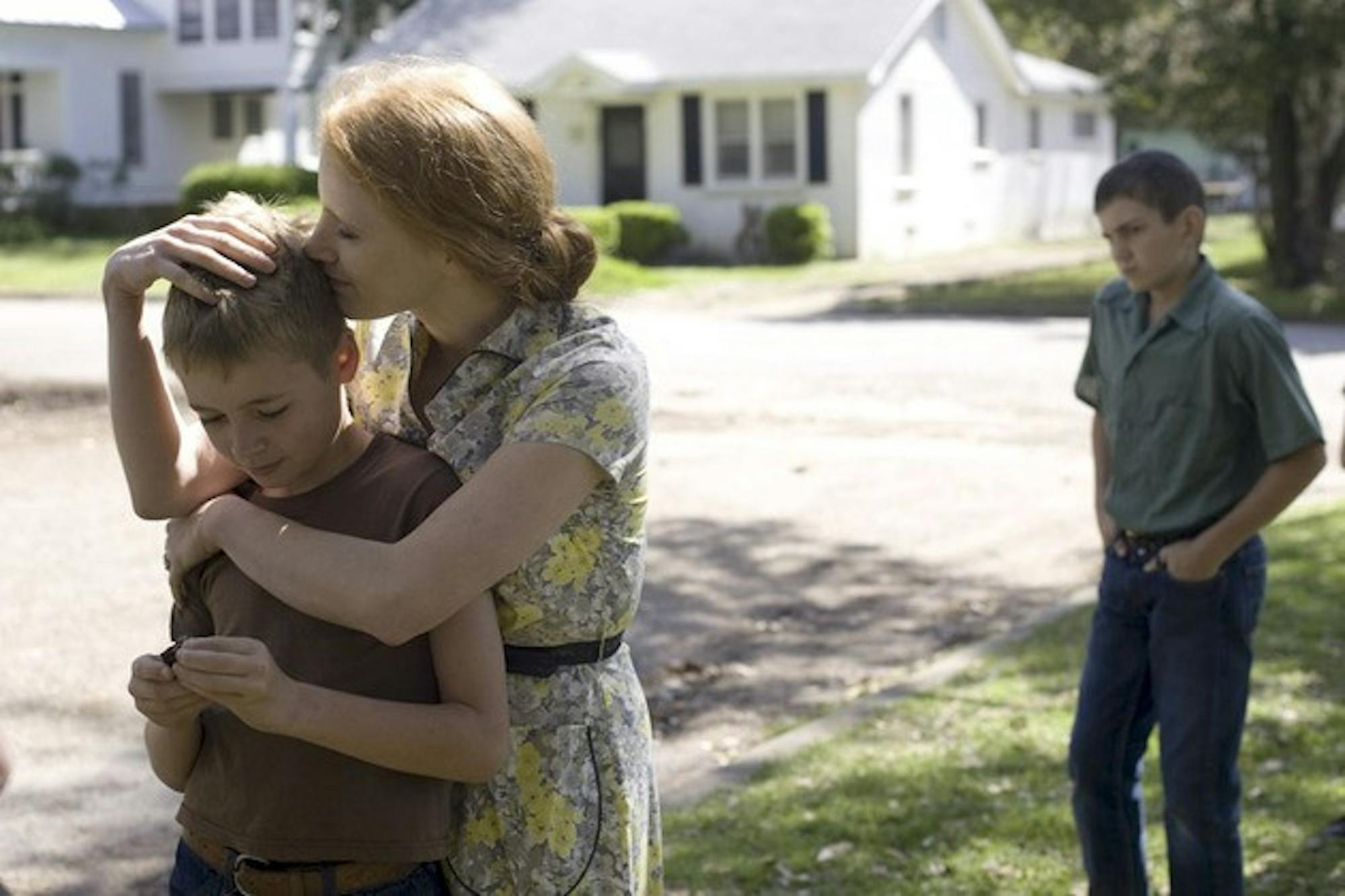"The Tree of Life," Malick's fifth feature in 38 years, has been in development for decades and missed multiple release dates before premiering at the 2011 Cannes Film Festival where it won the Palme d'Or, the festival's highest prize, awarded to the director of the best feature film.
Mr. and Mrs. O'Brien (Brad Pitt and Jessica Chastain) are introduced to us only moments before they hear the news of their youngest son's death at age 19. The tragedy haunts the film and propels the eldest son Jack O'Brien (Sean Penn), tormented as an adult by the death of his brother many years earlier, to reminisce over his childhood and the purpose of human existence from his ultramodern city life overshadowed by skyscrapers.
What captures and grounds the audience most especially an audience that lacks the patience to appreciate the re-occurring flickering flame motif that attempts to transition between scenes of family life and meteor showers is Jack's character as a child (Hunter McCracken). The boy, followed from his innocent infant years to his vandalizing early teens, carries the weight of revealing the O'Briens' family dynamic and instigating questions of existence to a higher power.
Jack poses questions to the creator "Where do you live?" asks him for help "How do I get back to where they are?" and recognizes his existence "Always you were calling me." These questions are not only posed to God but also to Jack's dead brother, instigating both scenes of the cosmos and surrealist renderings of birth and death: A young Jack swims from an underwater house into the arms of his mother and an older Jack walks alone through rocky terrain to a heavenly seaside where he is met by younger versions of his parents and brothers.
A line from Job, "Where were you when I laid the foundations of the Earth, when the morning stars sang together, and all the sons of God shouted for Joy?," quoted in the film's prologue, predicts Malick's attempts to glorify a secular Earth in a sacred manner. Embedded with elements of religion, the film follows a romantic Christian tradition and glorifies nature as sacred. From scenes of flowers on mountaintops to the wrinkles of a baby's feet, all images present aesthetic perfection thanks to production designer Jack Fisk and cinematographer Emmanuel Lubezki.
As Jack wrestles with existential questions, he also wrestles with the dichotomous characters of his father and mother. Both influence him in two distinctly different ways, as his father is stern and unyielding while his mother is innocent and loving. The family's struggles are balanced with Jack's internal struggles and the ultimately universal, timeless struggles that have marked Earth since its origin.
A bildungsroman, the film follows not only Jack and his two younger brothers, but also the development of the universe. In almost the ultimate coming-of-age film, Malick fears no boundaries human or galactic and allots equal screen time to both volcanic eruptions and games of baseball in suburban streets in the film, which is over two hours long. This decision polarizes audiences and impedes a wide positive reception.
Halfway through the film, viewers are left with fearful dread of the omnificent and oppressive opera requiems, which foreshadow the disappearance of post-war suburbia for scenes more akin to "Planet Earth." An impatient and unsuspecting audience member even the most cultured and tolerant will squirm during these transitions. Upon reflection, however, the film undeniably breaks ground in its visual approach to the portrayal of human nature.
"The Tree of Life" is a visual portrait. A sensual experience, it hinges on images and sounds, dismissing the importance of dialogue in preference of wispy voice-overs, which dominate and mute out a scene's actual dialogue. Music also replaces dialogue and is pivotal to the film instead of hearing the mother's half-hearted, playful attempts to scold her sons, we hear Bach's Sonata in D Minor.
The film's score by Alexandre Desplat "The Painted Veil" (2006) and "The King's Speech" (2010) harnesses church choir, opera and classical music, incorporating the well-known works of Gustav Mahler, Mozart, Bach, Gustav Holst and Bedrich Smetena. Music also plays an important role in the O'Brien family dynamic. Jack's now-dead brother was the most musically talented, following in the footsteps of Mr. O'Brien, who regrets failing to become a great musician and forces his children to listen to Brahms's Fourth Symphony during dinner.
Malick, who remains shy of fame, is as elusive a figure as his new film, which at times evades comprehension. Almost all of Malick's films live in the past, from "Badlands" (1973) to "Days of Heaven" (1978), but "The Tree of Life" covers simultaneously sterile city-life of the present day, the postwar climate of the 1950s and the Earth four billion years ago. As with his historical films "The Thin Red Line" (1998) and "The New World" (2005) that depict well-known events in an unprecedented light, "The Tree of Life" is a unique approach to the universal story of a family struggling with the death of their son.
"The Tree of Life" is a film that will be enjoyed by a small audience, appreciated by a slightly larger one and re-watched by very few. It is not a film to be casually watched on a Sunday evening, as it will leave most viewers unsettled and frustrated. The film's length, lack of a linear plot line and incoherence make this an inaccessible film for a large audience, yet it still demands attention for its visual beauty and the questions it manifests.




